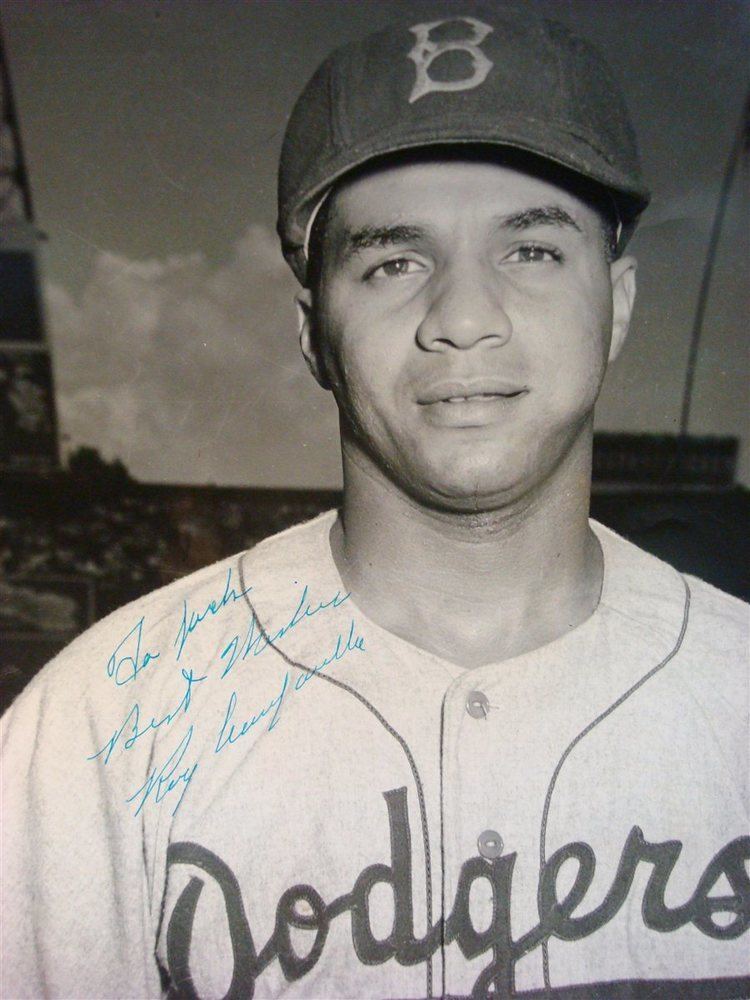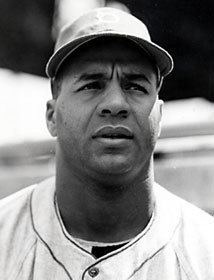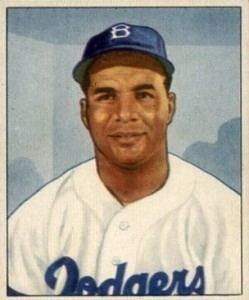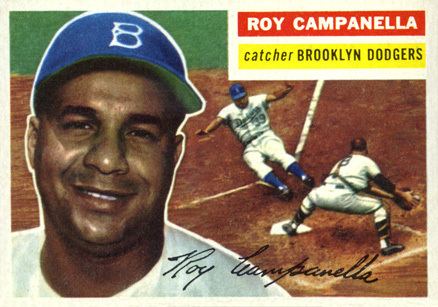Batting average .276 Vote 79.41% Home runs 242 Name Roy Campanella Books It's good to be alive | Runs batted in 856 Role Baseball player Children Roy Campanella II Inducted 1969 Height 1.72 m | |
 | ||
Similar People Duke Snider, Pee Wee Reese, Jackie Robinson, Willie Mays, Ted Williams | ||
Education Simon Gratz High School | ||
Roy campanella sung by dennis massa
Roy Campanella (November 19, 1921 – June 26, 1993), nicknamed "Campy", was an American baseball player, primarily as a catcher. The Philadelphia native played for the Negro leagues and Mexican League for several seasons before entering the minor leagues in 1946. He made his Major League Baseball (MLB) debut in 1948. His playing career ended in 1958 when he was paralyzed by an automobile accident.
Contents
- Roy campanella sung by dennis massa
- What s my line roy campanella ted husing panel sep 6 1953
- Negro leagues
- Mexican League
- Minor leagues
- Major League Baseball
- Automobile accident
- Post playing career
- Personal life
- Death
- Legacy
- References

Widely considered to be one of the greatest catchers in the history of the game, Campanella played for the Brooklyn Dodgers in the 1940s and 1950s. After he retired as a player, Campanella held positions in scouting and community relations with the Dodgers. He was inducted into the Baseball Hall of Fame in 1969.

What s my line roy campanella ted husing panel sep 6 1953
Negro leagues

Campanella's father John was the son of Sicilian immigrants. His mother Ida was African American. Therefore, he was effectively prohibited from MLB play before 1947, the season that black players were admitted to the major leagues for the first time since the 19th century. Campanella began playing Negro league baseball for the Washington Elite Giants in 1937 after dropping out of school on his sixteenth birthday. The Elite Giants moved to Baltimore the following year, and Campanella became a star player with the team.
Mexican League

In 1942 and 1943, Campanella played in the Mexican League with the Monterrey Sultans. Lázaro Salazar, the team's manager, told Campanella that one day he would play at the major league level.
Minor leagues

Campanella moved into the Brooklyn Dodgers' minor league system in 1946 as the Dodger organization began preparations to break the MLB color barrier with Jackie Robinson. For the 1946 season, Robinson was assigned to the Montreal Royals, the Dodgers' affiliate in the Class AAA International League. Meanwhile, the team looked to assign Campanella to a Class B league. After the general manager of the Danville Dodgers of the Illinois–Indiana–Iowa League reported that he did not feel the league was ready for racial integration, the organization sent Campanella and pitcher Don Newcombe to the Nashua Dodgers of the Class B New England League, where the Dodgers felt the climate would be more tolerant. The Nashua team thus became the first professional baseball team of the 20th century to field a racially integrated lineup in the United States.

Campanella's 1946 season proceeded largely without racist incidents, and in one game Campanella assumed the managerial duties after manager Walter Alston was ejected. This made Campanella the first African-American to manage Caucasian players of an organized professional baseball team. Nashua was three runs down at the time Campanella took over. They came back to win, in part due to Campanella's decision to use Newcombe as a pinch hitter during the seventh inning; Newcombe hit a game-tying two-run home run.
Major League Baseball
Jackie Robinson's first season in the major leagues came in 1947, and Campanella began his MLB career with the Brooklyn Dodgers the following season, playing his first game on April 20, 1948. He played for the Dodgers from 1948 through 1957 as their regular catcher. In 1948, he had three different uniform numbers (33, 39, and 56) before settling on 39 for the rest of his career.
Campanella played in the All-Star Game every year from 1949 through 1956. His 1949 All-Star selection made him one of the first four African-Americans so honored. (Jackie Robinson, Don Newcombe and Larry Doby were also All-Stars in 1949.) He hit home runs in five straight games in 1950; the only other Dodgers to homer in five consecutive games are Shawn Green (2001), Matt Kemp (2010), Adrian Gonzalez (2014–15), and Joc Pederson (2015).
Campanella received the Most Valuable Player (MVP) award in the National League three times: in 1951, 1953, and 1955. In each of his MVP seasons, he batted more than .300, hit more than 30 home runs and had more than 100 runs batted in. His 142 RBI during 1953 exceeded the franchise record of 130, which had been held by Jack Fournier (1925) and Babe Herman (1930). Today it is the second most in franchise history, Tommy Davis breaking it with 153 RBI in 1962. That same year, Campanella hit 40 home runs in games in which he appeared as a catcher, a record that lasted until 1996, when it was exceeded by Todd Hundley. During his career, he threw out 57% of the base runners who tried to steal a base on him, the highest by any catcher in major league history.
In 1955 (Campanella's final MVP season), he helped Brooklyn win its first-ever World Series championship. After the Dodgers lost the first two games of the series to the Yankees, Campanella began Brooklyn's comeback by hitting a two-out, two-run home run in the first inning of Game 3. The Dodgers won that game, got another home run from Campanella in a Game 4 victory that tied the series, then went on to claim the series in seven games when Johnny Podres shutout the Yankees 2-0 in Game 7.
Campanella caught three no-hitters during his career: Carl Erskine's two on June 19, 1952 and May 12, 1956 and Sal Maglie's on September 25, 1956.
After the 1957 season, the Brooklyn Dodgers relocated to Los Angeles and became the Los Angeles Dodgers, but Campanella's playing career came to an end as a result of an automobile accident. He never played a game for Los Angeles.
Automobile accident
Campanella lived in Glen Cove, New York, on the North Shore of Long Island; he operated a liquor store in Harlem between regular-season games and during the off-season. After closing the store for the night on January 28, 1958, he began his drive home to Glen Cove. While he was traveling at about 30 mph (48 km/h), his rented 1957 Chevrolet sedan hit a patch of ice at an S-curve on Dosoris Lane near Apple Tree Lane in Glen Cove, skidded into a telephone pole, and overturned, breaking Campanella's neck. He fractured the fifth and sixth cervical vertebrae and compressed the spinal cord. The accident left Campanella paralyzed from the shoulders down. With physical therapy, he was eventually able to regain substantial use of his arms and hands. He was able to feed himself, shake hands, and gesture while speaking, but he required a wheelchair for mobility for the remainder of his life.
Post-playing career
After his playing career, Campanella remained involved with the Dodgers. In January 1959 the Dodgers named him assistant supervisor of scouting for the eastern part of the United States and special coach at the team's annual spring training camp in Vero Beach, Florida, serving each year as a mentor and coach to young catchers in the Dodger organization. In 1978, he moved to California and accepted a job as assistant to the Dodgers' director of community relations, Campanella's former teammate and longtime friend Don Newcombe.
On May 7, 1959, the Dodgers, then playing their second season in Los Angeles, honored Campanella with Roy Campanella Night at the Los Angeles Memorial Coliseum. The New York Yankees agreed to make a special visit to Los Angeles to play an exhibition game against the Dodgers for the occasion. The Yankees won the game, 6–2. The attendance at the game was 93,103, setting a record at that time for the largest crowd to attend a Major League Baseball game. The proceeds from the game went to defray Campanella's medical bills. During 1969, Campanella was inducted into the Baseball Hall of Fame, the second player of African American heritage so honored, after Jackie Robinson. The same year, he received the Bronze Medallion from the City of New York.
Campanella was elected to the Mexican Professional Baseball Hall Of Fame in 1971. On June 4, 1972, the Dodgers retired Campanella's uniform number 39 alongside Jackie Robinson's number 42 and Sandy Koufax's number 32.
Personal life
Campanella was interviewed by Edward R. Murrow on the CBS program Person to Person on October 2, 1953 and again on January 2, 1959. Campanella also appeared as Mystery Guest on What's My Line? episode 171 on September 6, 1953 and as a guest celebrity on The Name's the Same (ABC-TV) on July 27, 1954. Campanella was also mentioned in the lyrics of the song "Did You See Jackie Robinson Hit that Ball?", written and recorded by Buddy Johnson in 1949 (and covered by Count Basie and his Orchestra that same year) and in the lyrics to the song "We Didn't Start the Fire" by Billy Joel. Campanella was also honored on the famous Ralph Edwards show This Is Your Life. Campanella appeared as himself in the Lassie episode "The Mascot", first broadcast September 27, 1959, in a story where he is coaching Timmy Martin's "Boys' League" team.
Roy Campanella's father was Italian and his mother was African American.(Jackie & Campy by William C. Kashatus, pp. 44) Roy was one of five children born to the couple. He was raised in a section of Philadelphia that generally had better race relations than much of the city. His easy going personality and strong work ethic were credited for his being able to move successfully between the races. Although Branch Rickey considered hiring Campanella to break baseball's color barrier, Rickey ultimately decided upon Jackie Robinson. Robinson and his wife stayed with the Campanella family during some ballgames because adequate hotels for blacks could not be found in the city.(Jackie & Campy by William C Kashatus, pp, 65-68 &75)
Campanella was married three times. His first marriage, to Bernice Ray on January 3, 1939, ended in divorce. They had two daughters together. On April 30, 1945, he married Ruthe Willis and had three children with her (including a son, television director Roy Campanella II). Their marriage deteriorated after his accident and was never the same; they separated in 1960 and Ruthe died during January 1963. Campanella's adopted son David had a somewhat troubled life; he was arrested a number of times, developed a problem with drugs and died at the age of 41. On May 5, 1964, Campanella married Roxie Doles, who survived him.
Death
Campanella died of heart failure at age 71 on June 26, 1993, at his home in Woodland Hills, California. He was cremated at the Forest Lawn, Hollywood Hills Cemetery in Los Angeles.
Legacy
In 1999, Campanella ranked number 50 on The Sporting News' list of the 100 Greatest Baseball Players, and was a nominee for the Major League Baseball All-Century Team.
The book Carl Erskine's Tales from the Dodgers Dugout: Extra Innings (2004) includes short stories from former Dodger pitcher Carl Erskine. Campanella is prominent in many of these stories. Campanella authored his autobiography, It's Good to Be Alive, which was published in 1959. Michael Landon made his TV-movie directorial debut in the 1974 movie It's Good to Be Alive, a heavily fictionalized version of Campanella's recovery after his accident. Campanella was portrayed by Paul Winfield.
Campanella was featured on a United States postage stamp in 2006. The stamp is one of a block of four honoring baseball sluggers, the others being Mickey Mantle, Hank Greenberg, and Mel Ott.
The Los Angeles Dodgers announced the creation of the Roy Campanella Award in September 2006. The award is voted on among the club's players and coaches and is given to the Dodger who best exemplifies "Campy's" spirit and leadership. Shortstop Rafael Furcal was named the inaugural winner of the award.
Simon & Schuster published a biography of Campanella in 2011 written by Neil Lanctot, author of Negro League Baseball – The Rise and Ruin of a Black Institution. The book is entitled Campy – The Two Lives of Roy Campanella. The book reveals new details about Campanella's near-fatal car accident and his stormy relationship with Jackie Robinson. It also provides the most comprehensive look at Campanella's Negro league career, including newly compiled year-by-year statistics.
SpiritClips.com, a sub-division of Hallmark Channel, released 'Roy Campanella Night', a 2013 short film documenting the period of paralysis leading up to the famous tribute to Roy Campanella on May 7, 1959 at Los Angeles Memorial Coliseum. The movie was directed by Chris Commons and stars Anthony Holiday, Tia Streaty and Nathan Wilson.
